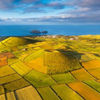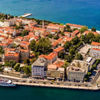Road cycling facts

- Road cycling routes on the Canary Islands
many
- Best time to travel
autumn to spring
- Flight connections
Edelweiss tips:
Whereas Gran Canaria, Tenerife and Lanzarote have long been known as road cycling destinations, the other main Canary Islands have also made a name for themselves in recent years. Spectacular volcanic landscapes, steep peaks and wide valleys with sometimes strong headwinds – the seven main islands boast an abundant variety. A bicycle helmet is required for cyclists on all of the islands and bicycle lights are highly recommended as many of the tunnels are not lit up. Cyclists who want to explore and experience several islands can opt to island hop by bike and ferry.
Top road cycling routes on the Canary Islands
Gran Canaria – endurance training in the Valley of the Tears Difficult
Gran Canaria is a favourite place for mountain-loving cyclists, offering challenging climbs up to an altitude of 2,000 m followed by downhill rides at incredible speed. The almost circular-shaped volcanic island features good roads and impressive volcanoes, such as Pico de las Nieves and Roque Nublo. Cyclists can ride almost to the top of Pico de las Nieves. The circular route from Maspalomas through the Valley of the Tears is one of the nicest on the island, although riding it requires pretty strong legs. Narrow winding roads meander up the slope and back down again. The Valley of the Tears starts after the village of La Aldea de San Nicolás and definitely lives up to its name – steep climbs with double-digit gradients in a valley with almost no shade. There are places to stop for refreshments and a bite to eat on the rewarding descent, however, places to refill water bottles in the valley itself are few and far between.
- Length of tour 9 h 15 min
- Distance 157 km
- Ascent 3’800 m
- Descent -3’800 m

Tenerife – uphill haven for well-trained cyclists Medium
Well-trained road cyclists will love Tenerife’s mountainous landscape. However, those epic views from the mountain summits come at a price, with most of the mountain passes involving steep climbs with gradients well over 10%. Especially in the summer months, cyclists in Tenerife are advised to start cycling in the early morning, as temperatures soon rise to above 30 degrees celsius. Standing at 3,718 m above sea level, Mount Teide is Tenerife’s highest peak – and also the highest mountain in Spain. Although the road up Teide only goes to 2,300 m, the circular trail via La Orotava to the Teléferico del Teide cable car still offers ample challenging ascents. The asphalted downhill ride to La Esperanza takes cyclists past the Teide Observatory, with several climbs in between, and delivers impressive views of Gran Canaria.
- Length of tour 8 h 55 min
- Distance 129 km
- Ascent 4’090 m
- Descent -4’080 m

Lanzarote – a year-round cycling destination Medium
Thanks to steady northeast trade winds, Lanzarote is ideal for cycling at any time of the year. With temperatures between 18 and 30 degrees celsius and a flatter topography than Gran Canaria and Tenerife, Lanzarote is the ideal place for some initial cycling tours ahead of the cycling season elsewhere. A week on Lanzarote is enough to explore every corner of the island by way of five or six road cycling tours. The Timanfaya National Park is particularly cyclist friendly, with designated ‘vías ciclistas’ (cycling tracks). The village of Yaiza marks the start of an impressive circular route through extraordinary volcanic landscape and across the winegrowing region of La Geria up to the summits of the national park.
- Length of tour 3 h 20 min
- Distance 70,6 km
- Ascent 770 m
- Descent -760 m

Fuerteventura – undulating road bike paradise Medium
Fuerteventura can be considered flatter than its neighbouring islands. The more mountainous part is situated in the southwest of the island. Having said that, the rest of the island’s topography is also undulating, which explains why the cumulative elevation gain tends to add up on long cycling tours. The island’s road network is in very good condition, and the local residents are accustomed to cyclists. The only place cyclists are advised to avoid is the traffic-heavy area around Puerto del Rosario. The tour from Gran Tarajal into the mountains to Tuineje and back has good roads and is recommended. It includes tackling one of the very few ascents on the island (just before reaching Tuineje), with a gradient of 13%. Nevertheless, this tour is on asphalt roads that are in superb condition.
- Length of tour 1 h 49 min
- Distance 40,6 km
- Ascent 400 m
- Descent 400 m

La Palma, La Gomera and El Hierro – challenging mountains and quiet roads
The mountains in La Palma are also challenging. In other words, road cyclists wanting to do tours of more than 100 km should expect a cumulative elevation gain in excess of 2,000 m. However, the side roads on La Palma are less busy than in Tenerife and Gran Canaria. The climb to Roque de los Muchachos at 2,500 m, followed by an almost 34 km descent, is a highly recommended cycling tour. The small island of La Gomera offers road cycling bliss away from the crowds, with challenging climbs, steep ravines and mostly traffic-free roads. However, cyclists must always watch out for potholes, especially on descent. El Hierro is the place to be for tranquillity and solitude – the westernmost part of the Canary Islands is impressive, with quiet and remote roads and idyllic places to stop and enjoy a bite to eat.
















 Sports equipment
Sports equipment
 Search flights
Search flights